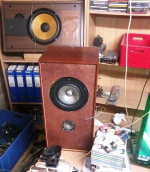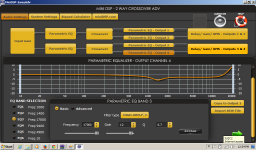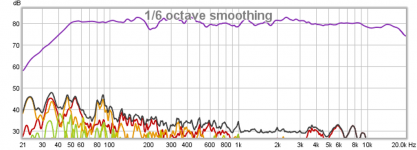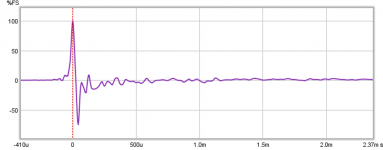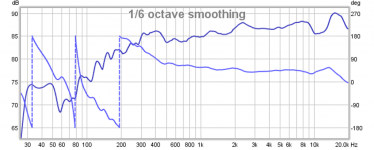Thanks for that Anthonybisset.
I was wondering what you meant by that short line about convolution.
That still keeps a lot of questions open though, at least in my mind. 🙂
I guess hearing is believing? Try a few solutions (if possible) and pick the one that feels best...
I was wondering what you meant by that short line about convolution.
That still keeps a lot of questions open though, at least in my mind. 🙂
I guess hearing is believing? Try a few solutions (if possible) and pick the one that feels best...
We're lucky because we can design systems with fewer compromises given our listening requirements (and for cheap!). Commercial design seems harder in that systems have to fit so many types of rooms and situations, which is where corrective EQ and convolution become pretty attractive. They can take a mass market solution the last 10% so it integrates acceptably well in a consumer environment (or they can slay it with boomy bass that moves it off the shelves only to eventually find it's way to the garbage).
While my ideal system involves no correction, I'm all for the light use of corrective EQ (of any type) or the application of convolution. In both cases we can reduce room and speaker non-linearity at the cost of introducing signal processing artifacts.
Something like DEQX can sound amazing if the room+speakers are already on their way towards optimal... OTOH, using drastic amounts of correction starts to introduce audible artifacts as XRK971 and others noticed when EQ'ing their systems flat (and creating lots of ringing and phase shift).
One thing I really want to recommend to those interested in improving their listening experience. Clap your hands, (without music playing), 🙂 and listen to the room decay... Try running a slow sine sweep and listening for crossovers (if you can hear them) and room ring out.. Try a square wave and see how well your speakers can do the impossible (moving finite mass infinitely quickly to a new position)... if you listen in an enclosed rectangle, hang some decorative carpets/blankets on 2 or 3 walls and repeat... Adjust coverage to match your ideal live sound taste... Enjoy. If you felt that was worth it, and you want to go next level, try some bass traps.. And if you've gone that far, it's time to build some custom diffusor panels and possibly helmholtz resonators for pesky peaks the traps didn't kill.
While my ideal system involves no correction, I'm all for the light use of corrective EQ (of any type) or the application of convolution. In both cases we can reduce room and speaker non-linearity at the cost of introducing signal processing artifacts.
Something like DEQX can sound amazing if the room+speakers are already on their way towards optimal... OTOH, using drastic amounts of correction starts to introduce audible artifacts as XRK971 and others noticed when EQ'ing their systems flat (and creating lots of ringing and phase shift).
One thing I really want to recommend to those interested in improving their listening experience. Clap your hands, (without music playing), 🙂 and listen to the room decay... Try running a slow sine sweep and listening for crossovers (if you can hear them) and room ring out.. Try a square wave and see how well your speakers can do the impossible (moving finite mass infinitely quickly to a new position)... if you listen in an enclosed rectangle, hang some decorative carpets/blankets on 2 or 3 walls and repeat... Adjust coverage to match your ideal live sound taste... Enjoy. If you felt that was worth it, and you want to go next level, try some bass traps.. And if you've gone that far, it's time to build some custom diffusor panels and possibly helmholtz resonators for pesky peaks the traps didn't kill.
Last edited:
Well the light use I'm personally looking for will end up looking like this:

But that's another story. I think XRK971 can benefit from far less EQ than that 😀.

But that's another story. I think XRK971 can benefit from far less EQ than that 😀.
Last edited:
I think XRK971 can benefit from far less EQ than that 😀 .
Hey, what are you trying to say? That I am EQ happy? 🙂 I use my EQ's very sparingly unless it is the subs in which case I force that puppy to be flat as a board from 50 Hz to 200 Hz. I have not noticed the room ringing like a bell with the bass yet so I guess it is OK. I learned my lesson so I don't mess with the tops except something similar to your graph to bring out that 18 to 20 kHz range. My dilemma is what to do about the baffle step loss? Is it OK to put a -6dB shelf from 1500 Hz on up? When I have time the best thing to do is try out the minimal EQ'ing and measure the near field phase to see if it gets messed up.
X-Nautaloss in general
Hi there X: listened to your broadcasts of Nautaloss projects tonight, stunning sound! Thanks for all your work to bring this technique to DIYAUDIO. ...regards, Michael
Here is what the Nautaloss II and Nautaloss sub + MLTL subs running through the miniDSP sounds like. This clip is full of textures and I picked it because you can hear the clean transients of the guitar, piano, and percussion. The speaker response is +/- 3dB from 42 Hz to 18 kHz and is playing at about 87 dB where the mic is. I think it is very neutral as there is no coloration, but because it is neutral, you hear a lot of nuances over the whole spectrum. Let me know what you think.
Hi there X: listened to your broadcasts of Nautaloss projects tonight, stunning sound! Thanks for all your work to bring this technique to DIYAUDIO. ...regards, Michael
Hey, what are you trying to say? That I am EQ happy? 🙂
More like the opposite 😉. I know you'd like transparent EQ, as would I. Your chances are better though (lol).
Pick drivers for LF that allow you to use only filter to shape response and do away with need for baffle step. In other words, get a . Linear woofer that is about 3dB's more sensitive than you need. I will be using the TD12 for my build and it has 93dBa sensitivity. It will allow crossing at baffle step with no compensation and relatively low filter slope. Overall system will be 90dB
your broadcasts of Nautaloss projects tonight, stunning sound! Thanks for all your work to bring this technique to DIYAUDIO. ...regards, Michael
Michael,
Thank you! Glad you liked it.
Are you going to build a Nautaloss?
Cheers,
X
Pick drivers for LF that allow you to use only filter to shape response and do away with need for baffle step. In other words, get a . Linear woofer that is about 3dB's more sensitive than you need. I will be using the TD12 for my build and it has 93dBa sensitivity. It will allow crossing at baffle step with no compensation and relatively low filter slope. Overall system will be 90dB
Where are you crossing over though? My baffle step starts at below 1500 Hz, and I want to cross low like no higher than 300 Hz for a FAST. TD15 is a nice driver but needs EQ to get any bass in a sealed box as the Qts is very small.
I have will have a wider speaker with faceted front. Should put the F3 in the 350-400 region and f6 250ish. Hardest thing about 3way is speaker shape and size. I love the imaging that monitors provide and the coherency that full range drivers provide. Not at all an easy task when using 3 elements.
Full range kinda ruins you once you have heard a good one.
Full range kinda ruins you once you have heard a good one.
Hi been away since yesterday, will now start trying two USB sound device for JRiver test, if its possible to use this as two way speaker active setup. After that will try measure if one of the identical named EQs in Jriver will give FIR and the other IRR or both is IRR. Last will test DEQ2496 if filters give IRR or FIR.
In meantime attach xps document (two zips) from Bodzio Software with pre post ringing examples, at page 6-8 is graphical shown some of the effect by anthonybisset hints for EQ cut verse boost. I have more interesting document from Bodhan, where speaker driver/system setups performing impressive square waves, xrk971 request if you like them attached here in thread.
At picture a test setup full ranger sealed preferred setup alone and EQed from DEQ2496. Intend a better FAST with this 4" FR paired with 15" for more SPL. But reason for picture is the impedance linearization (both resonance and inductor compensated) filter seen on top CD's which changes mostly dampening, and if interested xrk971 request more info.
In meantime attach xps document (two zips) from Bodzio Software with pre post ringing examples, at page 6-8 is graphical shown some of the effect by anthonybisset hints for EQ cut verse boost. I have more interesting document from Bodhan, where speaker driver/system setups performing impressive square waves, xrk971 request if you like them attached here in thread.
At picture a test setup full ranger sealed preferred setup alone and EQed from DEQ2496. Intend a better FAST with this 4" FR paired with 15" for more SPL. But reason for picture is the impedance linearization (both resonance and inductor compensated) filter seen on top CD's which changes mostly dampening, and if interested xrk971 request more info.
Attachments
Byrtt,
Yes, I am interested in seeing the square wave response. Please post. Hope your testing with the dual USB DAC was fruitful.
Thanks,
X
Yes, I am interested in seeing the square wave response. Please post. Hope your testing with the dual USB DAC was fruitful.
Thanks,
X
Judicious Use of EQ on Nautaloss I
OK, all this talk of having a light touch on the EQ got me to wondering what it could look like if I tried to cut peaks rather than fill valleys, and do it over a broad area. I implemented exactly 3 EQ filters:
1. High Shelf 1kHz, -3 dB, Q=0.4 (to help with the baffle step loss)
2. High Shelf 17kHz, +12 dB, Q=0.7 (to bring some air to the treble even though my ears can't hear above 17 kHz)
3. Peak, 1.4kHz, -4dB, Q=2.0 (reduce a peak that I am not sure what it is caused by? - this is the only narrow)
Here is what it looks like as implemented in the minDSP dialog:
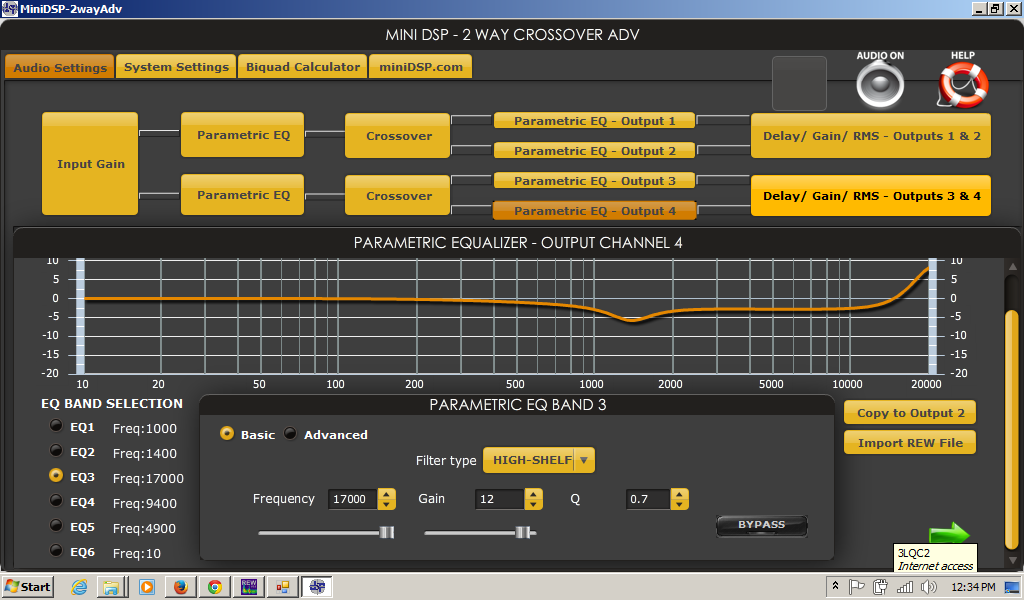
Here is how it measures at the listening position (about 2 m away)- this is quite a nice flat response that I think will reveal the true nature of a recording as the recording engineer intended. There is a dip at 200 Hz that is a room mode that I cannot get rid of without applying a lot of boost EQ so I left it alone. The harmonic distortion is amazingly low in the sub -50 dB and -35 dB in the bass region:
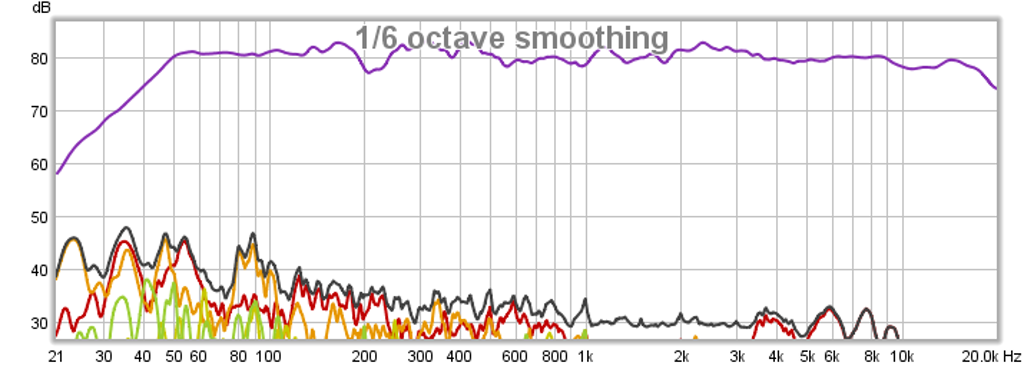
Here is the corresponding impulse response - very clean with the characteristic trailing overshoot introduced by the miniDSP that I demonstrated earlier:
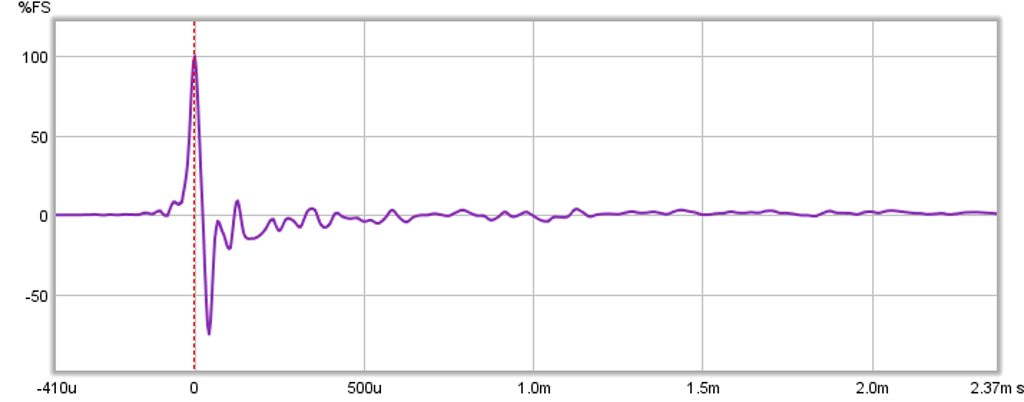
The big question is how does the above EQ affect the phase? To answer this, I placed the mic in the nearfield at about 10 in away and I get the following:
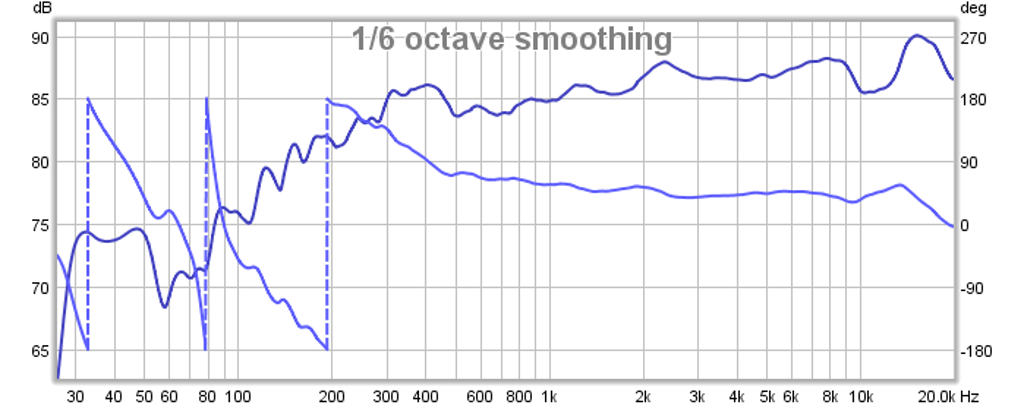
The phase is actually quite flat and does not wrap over the range of the Vifa from 200 Hz to 20 kHz. I think the light touch on the EQ worked and doing broad strokes and cutting tops rather than filling valleys worked well. The large +12dB high shelf at 17 kHz starts to make the phase distort but by the time you get to 20 kHz it is still reasonable, after that you can't hear it anyway...
Finally, how does it sound? I think it sounds really nice now. The imaging and sound stage are all there as well as the textures and dynamics. Here is a sound clip of something I listened to from YouTube as I don't have the recording yet - but this is a truly great track by SRV. Let me know what you think of the sound.
OK, all this talk of having a light touch on the EQ got me to wondering what it could look like if I tried to cut peaks rather than fill valleys, and do it over a broad area. I implemented exactly 3 EQ filters:
1. High Shelf 1kHz, -3 dB, Q=0.4 (to help with the baffle step loss)
2. High Shelf 17kHz, +12 dB, Q=0.7 (to bring some air to the treble even though my ears can't hear above 17 kHz)
3. Peak, 1.4kHz, -4dB, Q=2.0 (reduce a peak that I am not sure what it is caused by? - this is the only narrow)
Here is what it looks like as implemented in the minDSP dialog:

Here is how it measures at the listening position (about 2 m away)- this is quite a nice flat response that I think will reveal the true nature of a recording as the recording engineer intended. There is a dip at 200 Hz that is a room mode that I cannot get rid of without applying a lot of boost EQ so I left it alone. The harmonic distortion is amazingly low in the sub -50 dB and -35 dB in the bass region:

Here is the corresponding impulse response - very clean with the characteristic trailing overshoot introduced by the miniDSP that I demonstrated earlier:

The big question is how does the above EQ affect the phase? To answer this, I placed the mic in the nearfield at about 10 in away and I get the following:

The phase is actually quite flat and does not wrap over the range of the Vifa from 200 Hz to 20 kHz. I think the light touch on the EQ worked and doing broad strokes and cutting tops rather than filling valleys worked well. The large +12dB high shelf at 17 kHz starts to make the phase distort but by the time you get to 20 kHz it is still reasonable, after that you can't hear it anyway...
Finally, how does it sound? I think it sounds really nice now. The imaging and sound stage are all there as well as the textures and dynamics. Here is a sound clip of something I listened to from YouTube as I don't have the recording yet - but this is a truly great track by SRV. Let me know what you think of the sound.
Attachments
Last edited:
Looks like you had a great time. Stevie Ray Vaughn will do that to you...
Did you enjoy it? I got side tracked by this girl:
https://www.youtube.com/watch?v=eAxF_CSx7B4&list=HL1391965718
She performed in a bar 200 yards from my home...
Had a great time!
Did you enjoy it? I got side tracked by this girl:
https://www.youtube.com/watch?v=eAxF_CSx7B4&list=HL1391965718
She performed in a bar 200 yards from my home...
Had a great time!
She has a great unique voice - you live near a night club? I saw SRV at a concert in Los Angeles a year before we lost him - great show, and great performer.
No, just a bar around the corner... never expected to see something like her coming by...
She's got a great voice, born in south Africa... she came in second place at Rock Star Supernova...
We usually don't get things like this this close to home 😉...
From my phone:
http://www.youtube.com/watch?v=MmdAVE4iNQk
Would have loved to see Stevie Ray live though!
She's got a great voice, born in south Africa... she came in second place at Rock Star Supernova...
We usually don't get things like this this close to home 😉...
From my phone:
http://www.youtube.com/watch?v=MmdAVE4iNQk
Would have loved to see Stevie Ray live though!
Last edited:
Hi there X: Yes, I will DIY a Nautaloss, as I understand the utilization, closed TL with response similar to infinite baffle or OB (without back wave). Therefore low cut off will never go below Fs. Chose sub driver for Fs to match requirements and have Qts be in the high range, as would be used for OB. Establish path length to match low cut off at Fs. TL,s are often designed shorter than 1/4 wave Hz, cut off (often given in the range of 0.65xFs.) However, shortening the line reduces volume, so when proportioning the spiral, should this lost volume be made-up by increasing the large end of the line to maintain low bass response? Since you have covered the top end of a FAST thoroughly, I've addressed the bass section questions here. Although I've posted late at night, I'm really not Night Owl Audio. ...regards, Michael
Michael,
Your understanding of the Nautaloss TL is spot-on. You are correct about maintaining enough volume for the high Qts driver to achieve good bass extension. Due to a high Qts driver's less powerful motor, a too small of a volume may not work. Yes, you can achieve volume adjustment in the front larger portion. However, I have found that making the Nautaloss, the volume tends to be on the big side already so you will not have a problem achieving sufficient volume. One way to make it work with a volume half the ideal is to double up the drivers face-to-face like I did. It essentially becomes an isobaric setup and allows the volume to be half the usual size (essentially the motor strength went up by 2x). This will also give improved bass transient response. If you are using inexpensive drivers this can work well and also provide a lot of built in low pass filtering.
Your understanding of the Nautaloss TL is spot-on. You are correct about maintaining enough volume for the high Qts driver to achieve good bass extension. Due to a high Qts driver's less powerful motor, a too small of a volume may not work. Yes, you can achieve volume adjustment in the front larger portion. However, I have found that making the Nautaloss, the volume tends to be on the big side already so you will not have a problem achieving sufficient volume. One way to make it work with a volume half the ideal is to double up the drivers face-to-face like I did. It essentially becomes an isobaric setup and allows the volume to be half the usual size (essentially the motor strength went up by 2x). This will also give improved bass transient response. If you are using inexpensive drivers this can work well and also provide a lot of built in low pass filtering.
The summer we lost SRV, I was at a water ski tournament in southern Illinois. The lake was on the county fair grounds and the local fair was going on at the same time. Midway through our event a helicopter flew onto a pad just across the lake from us (these lakes are very narrow). I was told, never knew for sure, that SRV was performing at the fair and it was his chopper. Watched it fly out a day or so later only to hear of his tragic crash the following week. One can only imagine all the musical contributions he would have continued to make.
On the rhythm side, we lost another great last year, a favorite, Mr. JJ Cale. The good news for us… they live on…as we continue to enjoy their amazing work.
On the rhythm side, we lost another great last year, a favorite, Mr. JJ Cale. The good news for us… they live on…as we continue to enjoy their amazing work.
- Home
- Loudspeakers
- Full Range
- The Nautaloss Ref Monitor
